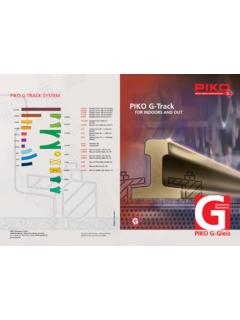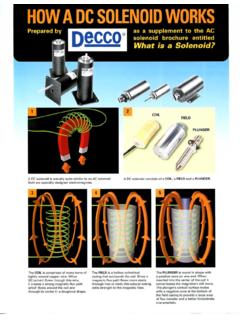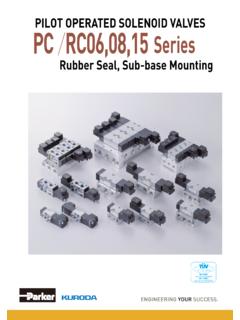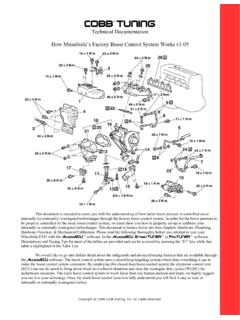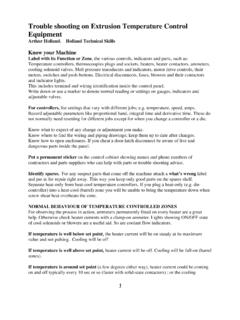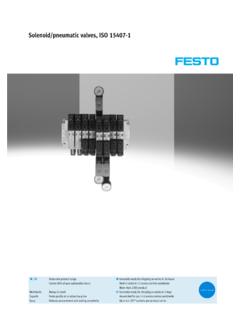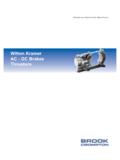Transcription of Wiring the track In plain English, with diagrams!
1 A DCCconcepts Modelling advice publication DCCconcepts Pty Ltd, 3/13 Lionel St., Naval Base WA 6165 Australia. * * +61 8 9437 2470 * DCC Advice #11 Page 1 Wiring Point-work & Special track conditions for DC or DCC Wiring the In plain English, with diagrams! If we had a $ or or for every time we ve been asked how to wire track and point-work, we d be writing this on a beach somewhere while sipping a cold beer! A great layout needs good trackwork, so first - a word about trackwork and getting good performance. Choose carefully! DO think about making your own turnouts if you have even moderate skills. It is not as hard as you think, needs only basic skills and and we do our best to make it easy with our top quality gauges, trackwork frets and templates. PLUS we will soon provide a detailed How to make track tutorial too.
2 Interested? Then call or email us and we will do our best to help you. No matter what scale you will model in, DO NOT even consider using insulated frogs! Yes, lazy retailers who do not understand what they sell - and modellers who have never done a proper job of laying track so it runs well may well recommend it to but do NOT be tempted. No matter which brand makes the turnouts, if you use insulated frogs, you WILL have small locos stalling or also suffer from wider wheels bridging the frog tip and creating momentary shorts that are hard to fix and really are a source of constant frustration. Use more realistic rail sizes please: Usually this will be code 55 in N, or Code 75 and 83 in OO or HO Scale. Unless most of your stock is old Lima or older European prototype with deep flanges on the wheels that could cut pizza s, please do NOT use code 100 track .
3 It looks over-scale and your whole layout will never look as good as it could with code 75 or code 83 rail. (by the way the code isn t very clever or special - it is just the height of the rail in thousandths of an inch) There is a practical reason for using smaller rail sizes EASIER laying - smaller rail profiles look better but they are also MUCH easier to work with because they bend more naturally and more easily and that makes it easier for you to lay track -work that flows well from straight to curve The range of turnouts is nicer too. Leave the code 100 for fiddle-yard or train-set use! Speaking of point-work and turnouts: Stick with Medium-to-large radii for all this is because small radius turnouts always have problems with larger locos and longer rolling stock, You WILL get poor running and derailments if you use them.
4 They look toy-like too of course! We will cover only the Wiring of live-frog turnouts here, because that is how it should be done for best performance. DC or DCC. It s easy to do and you ll be glad you did it right when it runs well! Stick with ONE track standard if you can. We ll talk only ready to run HO/OO here and It may change (actually it WILL, soon) but right now, Peco Electro-frog code 75 is the most usable for UK prototype modelling and not bad for US modellers too, the Tillig Elite code 83 range is excellent for those who model European & Peco code 83 would be my first choice for US modellers. SO - Lots to think about. Meanwhile, on to Wiring point-work & special Wiring conditions. A DCCconcepts Modelling advice publication DCCconcepts Pty Ltd, 3/13 Lionel St., Naval Base WA 6165 Australia. * * +61 8 9437 2470 * DCC Advice #11 Page 2 Wiring Point-work & Special track conditions for DC or DCC #1.
5 The basics of Wiring a turnout correctly. We also cover this subject in detail in another advice chapter Advice #2 Making Peco better . That bulletin also includes how to improve the look of a Peco point, so the more adventurous among you might like to check it out! Basically what we need to do is easy, as most of the prep work is now done for you by Peco. That s it - This is the first step in preparing ANY point-work for use, & now you are ready to go. Easy wasn t it. This same principal applies equally to ALL Peco point-work in OO and HO. Other brands may be structured a bit differently but the same principal applies - Isolate the frog so it can be switched with the turnout, and remove ALL reliance on physical blade contact by binding all closure rails and blades on the same side of the turnout together.
6 By the way - N scale Peco is designed slightly differently and I m assured by modellers in N that the gaps & links aren t needed due to these differences, so if you are in N, you may skip the gapping/bonding part. It s up to you. #2. The basics of using insulated joiners or isolating gaps. Follow this simple principal. Frogs need to be live, so they always need to be isolated. This is easy to do - and you will find that even for a novice, its easy to work out where it needs to be done. To make this (&the rest of the text of this document) simpler, we will use some of the terms that commonly understood in relation to point-work or turnouts. here is our 1,2,3 of terminology to make it easier. (1) Point, switch, turnout, whatever: We will call it all pointwork and Turnouts from now on. (2) Look at the turnout images above.
7 The green part is actually called the common crossing, but the pointy bit where the two rails converge at the LHS is more commonly called the Frog by modellers, so Frog it is! (3) Look at the turnout images above. Think of a shoe. The LHS is called the HEEL. The RHS is called the toe. Now - on to the next steps. We ll move on to adding point-work in combinations and on a layout! Step 1 - improve the power flow (1) turn it over. You should see a wire attached to the frog area. Pull it from its slot ready to attach a Green drop-per (it ll be connected to the common wire of one of Cobalt's switches) (2) There are two orange bars on the drawing to the left. These are wire links you should add (solder them between stock and closure rails). (3) There are two red lines. Older turnouts will need the rails cut here. Newer turnouts already have the rails gapped.
8 , but there will be wire links Please remove or cut them. That s it - just wires to attach now! Step 2 - attach the droppers (1) attach the green wire to the frog. Connect it to the common terminal of one of Cobalt s built-in high-power SPDT switches. (2) Attach the other 2 wires (the red and black) for the track power to the blue and red rails. These wires go to the other two terminals on the same Cobalt switch. Now, when you change the turn-out, the polarity of the frog will change to match the route and you will have perfect running! These quick & simple improvements will give better overall reliability with both DC and DCC powered layouts. A DCCconcepts Modelling advice publication DCCconcepts Pty Ltd, 3/13 Lionel St., Naval Base WA 6165 Australia. * * +61 8 9437 2470 * DCC Advice #11 Page 3 Wiring Point-work & Special track conditions for DC or DCC Wiring AND SWITCHING FROGS - Lets get the basics sorted out first.
9 For this, we will use the basic crossover to give you a guide for polarity & frog isolation that works in all circumstances. Once we have prepared the point-work, the hard work is done and Wiring is easy. Here is a very simple rule to follow. When any two points face each other, the frog rails need to be isolated These examples show this perfectly. It is just two points in a crossover, but it shows why and where frog isolation needs to exist. Use these examples as your guide and you ll be able to do anything you need! Switching the frog is easy with DCCconcepts products. (The Frog wire is shown in green) Using Cobalt or iP Analog Using Cobalt iP Digital Using AD-S2 or AD-S8fx (For all Solenoid brands) The Left & Right wires may need swapping as this depends on the actual point-work orientation Look at the PINK circles This is WHERE Isolation gaps are needed wherever ANY TWO points face each other, Heel-to-Heel Two points in a crossover: North rail blue, South Rail Red Frogs not yet considered Two points in a crossover: Set to main line North rail blue, South Rail Red North Frog to RED rail South Frog to BLUE rail Two points in a crossover.
10 Set to crossover North rail blue, South Rail Red North Frog to BLUE rail South Frog to RED rail Look at the PINK circles This is WHY Isolation gaps are needed wherever ANY TWO points face each other, Heel-to-Heel Look at the PINK circles This is WHY Isolation gaps are needed wherever ANY TWO points face each other, Heel-to-Heel Frog = Green Frog = Green Frog = Green A DCCconcepts Modelling advice publication DCCconcepts Pty Ltd, 3/13 Lionel St., Naval Base WA 6165 Australia. * * +61 8 9437 2470 * DCC Advice #11 Page 4 Wiring Point-work & Special track conditions for DC or DCC A reminder - ALL examples and the things we use for switching such as Cobalt motors, Cobalt-S levers and AD or AD-S accessory decoders will work as well on DC as they do on DCC, so you can use these diagrams for ANY layout, with ANY form of control.







